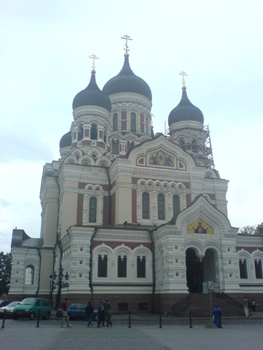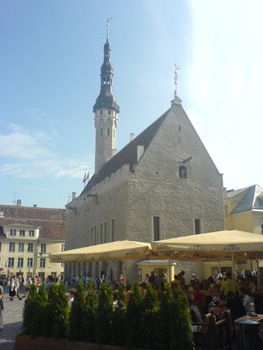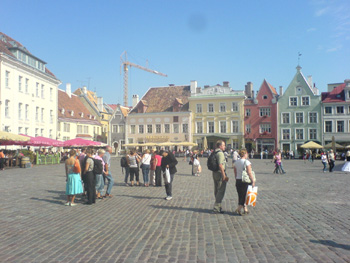
I think that this building (the Alexander Nevsky Orthodox Cathedral in Tallinn) is every bit as assertively a statement that the Russians are in charge as is the Palace of Culture in Warsaw I wrote about earlier this year. It comes from a different Russian era (the Cathedral is a Czarist structure, completed in 1900), but I think the motives for building the two structures were not too different . Certainly the Cathedral is in every bit as prominent a location as the Palace of Culture – it is on the top of the Toompea hill in Tallin’s Old Town, directly opposite Tallin castle (now the Estonian national parliament). Certainly, also, it is every but as architecturally out of character from the historical city, which in style is a typical Baltic Hanseatic League city, although the people of the city are clearly very proud of the medieval town hall


It is only six years since I was last in Tallinn, but the city certainly seems to have come a long way since then. At that point the Old Town was beautiful, but the rest of the city felt grimy when I left it. No longer. It’s not a terribly large city (half a million?) and it is not as frenetic as some larger cities, but it has the air of a place becoming, well, comfortable. Modern office buildings going up. Suburban tracts of nice, large houses being built on the waterfront to the west of town. That kind of thing. There are lots of Soviet housing estates between the old centre and the nice suburbs, but in truth I have seen worse in London. And Paris. And Amsterdam. It is difficult to believe that this was part of the Soviet Union only fifteen years ago. But it was.
And it was certainly a nice touch to be able to talk to friends in Australia using a software product that was developed here. The computer markets of China are full of people attempting to sell you cheap Skype handsets. However, Tallinn gave us Skype itself. That is worth more.




I have heard Tallinn described as being the “Babe capital of the world” (even more so than Prague), so please Michael, use your camera to prove or disprove that claim 🙂
Who do you think I am, David? Perry?
Whatever the motives of the Russians in building the Orthodox cathedral it is a lot better looking that most Soviet buildings.
Nor do the major buildings of a city all have to be in the same style – indeed having buildings of different styles can be nice. For example, I have no problem with a mixture of classical and gothic buildings in a city (although they can jar sometimes if right next to each other – in depends on what sort of “classical” and “gothic” style we are dealing with).
As a general rule of thumb the question to ask is not “are all the major buildings in the same style”, but “do all the buildings look like they were designed before 1914”
I know this is a bit hard on some modern styles of building (which can be good) – but it is a general rule of thumb.
It is even true of housing.
The Victorian working class houses may have been terrible places to live (big families in small, cold, damp houses) and the cottages of pre Victorian times may have been terrible to (for the same reasons).
But improved and with less people in them they are fine – they look O.K.
The council houses of the 1920’s and 1930’s mostly look ugly (even if they have a lot of money spent on them) and they stand out in their uglyness in so many towns and villages in the United Kingdom (and even in the Isle of Man).
As for post World War II government housing – best not to think about it.
Of course major office buildings are known for such things as one having to have the lights on during the day, the rain leaking in and all sorts of other problems.
At least the old “cult of concrete” seems to be going, but it does seem to have been replaced by a “cult of glass” (the glass buildings look better, but I have a feeling there are going to be problems).
Michael, what is the beer like?
The beer is excellent, and inexpensive. (A half litre of beer costs 30 kroon (about £1.30) in bars in central Tallinn – probably less in less fashionable areas). I have been drinking a style of dark beer that appears to go under the name of “tume”. I have had quite similar beers in Poland, although not under that name.
I have heard Tallinn described as being the “Babe capital of the world”…
This would adequately describe any former Soviet city with a population over 200,000. The Soviets might have been utterly useless at most things, but they were excellent at churning out stunning women.